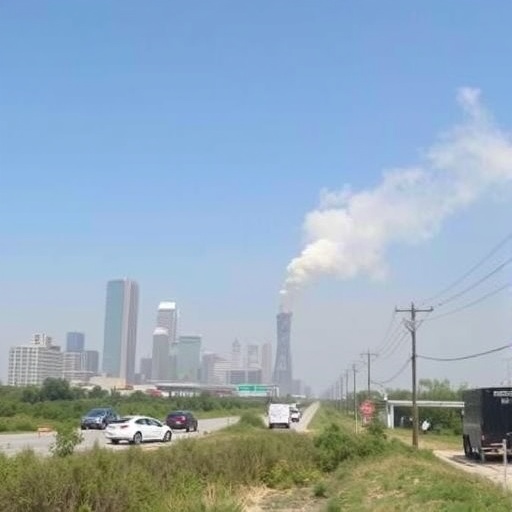As the climate crisis intensifies globally, regions like Texas are experiencing increasingly severe, frequent, and long-lasting heatwaves that pose significant health risks. In 2023 alone, over 300 heat-related fatalities were reported in Texas, marking the highest toll since official tracking began in 1989. While elevated temperatures clearly strain human health, recent research suggests that the dangers of heatwaves extend beyond temperature extremes alone, involving complex atmospheric chemical changes that exacerbate air pollution levels and, consequently, public health risks.
At the forefront of this emerging field is Bianca Pamela Aridjis-Olivos, a graduate student specializing in aerosol and atmospheric chemistry at Texas A&M University. Aridjis-Olivos and her research team from the Center for Atmospheric Chemistry and the Environment (CACE) have embarked on a pioneering pilot study to unravel the intricate interactions between extreme heat and atmospheric pollutants. Their findings, unveiled at the American Chemical Society (ACS) Fall 2025 meeting, underscore a surprising and concerning phenomenon: heatwaves not only raise ambient temperatures but also drive chemical transformations in the air that amplify pollutant concentrations, including ozone and volatile organic compounds (VOCs).
The team’s fieldwork was meticulously conducted during the 2024 Texas heatwave, spanning from early August to early September. They strategically collected air samples at various times throughout the day and night on the Texas A&M campus in College Station, a region that experienced temperatures soaring between 90 and 106 degrees Fahrenheit (32 to 41 degrees Celsius) during this period. A critical aspect of this sampling campaign was the absence of wildfire smoke influence, a common confounder in air quality studies, which allowed the researchers to isolate the direct impacts of heat alone on atmospheric chemistry and pollutant dynamics.
Utilizing advanced analytical instrumentation, most notably the Proton Transfer Reaction Time-of-Flight Mass Spectrometer (PTR-ToF-4000), the research group could detect and quantify trace gases and measure aerosol properties in real-time. The PTR-ToF-4000 works akin to a highly sensitive electronic “nose,” capturing volatile organic compounds with exceptional specificity and sensitivity while maintaining gentle ionization processes to preserve molecular structures—a crucial feature for accurately identifying complex atmospheric VOCs. This methodological sophistication enabled the team to dissect the chemical composition of air samples with unprecedented granularity during extreme heat conditions.
Preliminary data revealed alarming trends: concentrations of ozone, oxygenated VOCs, and acid-rich nanoparticles incrementally escalated with rising outdoor temperatures. These compounds are well-known contributors to respiratory and cardiovascular health problems, intensifying the public health burden during heatwaves. Importantly, the study highlighted how photochemical reactions, fueled by intense sunlight prevalent during heatwaves, catalyze the formation of these pollutants through complex interactions among various chemical species in the atmosphere.
One of the study’s most intriguing findings involves natural emissions from trees, particularly isoprene—a biogenic volatile organic compound emitted predominantly by oak trees, abundant in College Station. While these tree emissions are typically benign, under the influence of intense solar radiation and coexisting anthropogenic pollutants like nitrogen oxides (NOx), they participate in atmospheric reactions that produce hazardous secondary pollutants such as ozone and secondary organic aerosols (SOAs). These secondary pollutants have substantial implications for air quality, particularly in heavily wooded urban and suburban regions where natural VOC emissions synergize with human-generated emissions.
The team’s observations underscore a critical, yet underappreciated aspect of heatwave pollution dynamics: the interaction between natural biogenic emissions and anthropogenic pollutants accelerates during extreme heat events, leading to a notable increase in harmful atmospheric constituents. This intricate relationship complicates air quality management because controlling anthropogenic emissions alone may be insufficient to mitigate health risks exacerbated by climate-induced natural emissions.
Beyond the scientific revelations, the research provides timely public health guidance for communities navigating heatwaves compounded by worsening air quality. Advisories include remaining indoors during peak sunlight hours—from noon to 4 p.m.—when both heat and ozone levels peak, avoiding outdoor exertion in proximity to urban heat islands and traffic corridors during heat extremes, attentively monitoring air quality indices, and limiting indoor exposure to outdoor air pollutants by keeping windows closed. While these recommendations offer immediate protection, researchers emphasize that long-term mitigation requires deeper understanding and predictive capability regarding how climate change alters atmospheric chemistry.
The broader implications of this work extend into climate science, environmental policy, and public health domains. Gaining deeper insight into gas-to-particle conversion, VOC emissions, and photochemically driven secondary pollutant production under heatwave conditions is essential for devising accurate air quality models. Such models are critical for forecasting pollution episodes, guiding emission control strategies, and designing urban landscapes resilient to increasingly frequent heat extremes. The Texas A&M research contributes valuable empirical data to support these goals amid an evolving climate paradigm.
Funding for this innovative study was provided through Texas A&M University’s ASCEND seed grant initiative, the university’s vice president of research, and the Center for Atmospheric Chemistry and the Environment. These investments highlight the priority accorded to understanding climate-atmosphere-health interconnections, signaling a commitment to multidisciplinary approaches crucial for addressing the multifaceted challenges posed by global warming.
As the planet warms and heatwaves become an entrenched feature of many regions, studies like this underscore the urgency of integrating atmospheric chemistry insights into public health and environmental management. They reveal that heatwaves are not isolated temperature phenomena but complex events reshaping air quality and health outcomes. By bridging laboratory-grade chemical analysis with real-world field observations, Aridjis-Olivos and her colleagues illuminate pathways toward preparedness and resilience strategies vital for safeguarding populations facing the warming world.
Subject of Research: Effects of Heatwaves on Atmospheric Chemistry and Air Quality
Article Title: Measuring gas-phase air pollutants during heatwave conditions
News Publication Date: August 18, 2025
Web References:
https://acs.digitellinc.com/live/35/page/1204
https://www.epa.gov/climatechange-science/extreme-heat
Keywords: Atmospheric chemistry, Climate change, Heatwaves, Air pollution, Volatile organic compounds, Ozone, Secondary organic aerosols, Proton transfer reaction mass spectrometry, Texas heatwave, Public health, Photochemistry, Biogenic emissions




